
Attributed to: Allison Freedman, Product Marketing Manager, Keysight Technologies
 The communication network infrastructure of data centers, telecom companies, and militaries are vast and complex. Their operations, uptime, performance, and security have always required constant monitoring. The increasing popularity of cloud computing and artificial intelligence has further complicated these networking concerns. Additionally, regulators, investors, and customers are paying increasing attention to the sustainability, energy consumption, and emissions of networking infrastructure.
The communication network infrastructure of data centers, telecom companies, and militaries are vast and complex. Their operations, uptime, performance, and security have always required constant monitoring. The increasing popularity of cloud computing and artificial intelligence has further complicated these networking concerns. Additionally, regulators, investors, and customers are paying increasing attention to the sustainability, energy consumption, and emissions of networking infrastructure.
In this demanding business environment, digital twin technology and automation offer solutions for many networking challenges.
A network digital twin is a highly detailed virtual model of a real wired or wireless network that models its architecture and components while accurately mirroring its real-time state, configuration, and behaviour. This digital model is a safe environment for analyzing, optimizing, and predicting network performance and behaviours under various scenarios.
A network digital twin models the dynamic behaviour and functionality of a wired or wireless network, and it communicates with the physical network and its network management systems to obtain real-time data like its network metrics and traffic. It can send reconfiguration commands to the physical network’s devices for optimizing some aspects of the network, and it can use physical and environmental data collected from temperature sensors or data acquisition systems to inform its optimization strategies. This is unlike traditional network management where network planning generally does not consider such aspects directly.
Another major difference is that a network digital twin replicates the physical network for its entire lifespan. So the twin must accommodate long-term activities like equipment upgrades, downtimes, and decommissioning. In contrast, network models and simulators are generally only used in initial design stages until the network is deployed.
Network twins can therefore transcend the restrictions of physical networks, in terms of costs, security policies, and allowed configuration changes. The twin is an enabler of a higher level of decision-making that’s based on aggregate network performance metrics, environmental factors, regional traffic patterns, sustainability goals, and other such factors that are traditionally outside the scope of network management.
The most important component of a network digital twin is the network topology. It models all the relevant network devices with their layer two and layer three identifiers, and their connections relevant to the use case.
Other key components of network digital twins include device characteristics of the network equipment, control and application traffic as well as traffic profiles for various use cases, network and device configurations, various network protocols and their required data for realistic emulation, cybersecurity aspects like firewall rules, device vulnerabilities, and possible cyber attacks, physical environment of the network, and device locations and surrounding land topology for use cases like telecom networks.
Cybersecurity posture
The physical network’s cybersecurity posture, consisting of its network security and data security aspects, is a crucial input for developing a high-fidelity network digital twin.
Security-related inputs to network digital twins include vulnerability assessments. Vulnerabilities in the physical network are identified using vulnerability scanners. These assessments become inputs to the modeling of cyber attack scenarios using the network digital twin. The configurations of security devices like firewalls, intrusion detection and prevention systems, and physical access control systems are also crucial inputs to digital twin scenarios.
These inputs are used to model cyber attack scenarios. Different types of cyber threats are modeled and simulated in the controlled, isolated virtual environment of a network digital twin. They include denial of service, malware, intrusion, and eavesdropping attacks. These simulations enable security engineers to understand network behaviours and operational functionalities when under attack.
AI techniques like reinforcement learning can be trained to test long and complex exploit chains on the network digital twin. Generative neural networks like large language models can extract useful information from security-related vulnerability, incident, and assessment reports and dynamically generate appropriate exploit code. This code is run on the digital twin to simulate a cyber attack and study its impacts.
Realistic simulations often uncover previously unknown vulnerabilities in the network. These new weaknesses are added to the vulnerability database for future simulation cycles. And cyber attack mitigation and remediation workflows can be tested and hardened on the network twin in preparation for real attacks.
These network security applications on the digital twin help to discover more resilient network architectures and device configurations, which can then be applied to the physical network.
AI for network digital twins
In large enterprise networks, many intangible interactions and invisible cause-effect relationships exist. For example, a changed router configuration in part of a network may result in a kind of butterfly effect on the latency of an entire segment of the network.
AI enables the modeling and discovery of such emergent phenomena and latent relationships that lie hidden in the network and surface only under specific conditions. The training data for such AI models is obtained by simulating relevant traffic on the digital twin and recording network configurations and metrics.
Some concrete examples of such AI-enabled digital twin studies include reinforcement learning run on digital twins to simulate what-if scenarios, , the application of machine learning (ML) techniques to network data from digital twins to enable advanced optimizations that are generally not considered when managing typical physical networks. ML models can use aggregate metrics like a geographical area’s net throughput or environmental factors like power consumption — factors that are normally outside the scope of network management — to suggest optimizations.
For failure analysis, patterns in network failures and outages can be identified using algorithms like anomaly detection and time series forecasting on the metrics collected from the digital twin. Troubleshooting procedures for them can then be formulated and verified on the twin.
Network digital twin challenges
Implementing and maintaining network digital twins are not without challenges.
Networks can involve hundreds to thousands of network devices, each with its own complex configuration and behaviour. For example, 5G/6G telecom and data center networks are vast and complex, while the aim is to accurately model the network dynamics resulting from the interplay of relevant communication protocols, system configurations, network topology, physical network environment, and application traffic observed in specific scenarios.
Modeling and simulation must be at a speed and scale required to get statistically valid and meaningful results without compromising accuracy but, over time, there is a risk of configurations and behaviours programmed in a network twin diverging from those of the underlying physical network. To minimize this, automation needs to regularly sync the networks as well as sync them after any manual configuration changes.
Syncing requires real-time integration between the physical network’s hardware and software and the ones modeled in the twin. This can be very challenging because of multiple vendors and a lack of standardization in hardware and software interfaces. But these issues can be minimised by limiting the scope of a network twin to address specific problems.
Going forward, practical use cases for network digital twins include dynamic network planning and optimization of data centers based on device locations, power usage, power capacity, and other such factors.
For example, temperatures and power consumption can be measured using internet of things (IoT) sensors or data acquisition (DAQ) systems connected to racks. If these metrics start crossing some thresholds, traffic can be throttled or dynamically routed through other paths to keep them under control.
Such measures are increasingly necessary to comply with sustainability and emission targets mandated by regulations.
Network digital twins can also dynamically optimize routing and power configurations of optical networks, based on measurements of physics phenomena like attenuation, dispersion, and nonlinear effects.
In mobile networks, network twins can use real-world factors like channel congestion and radio frequency power to dynamically optimize beamforming parameters, network element configurations, power usage, and more.
If such dynamic changes are applied directly to a physical network, it can degrade the quality of service for users or inadvertently breach emission power limits. However, engineers can safely experiment with them on the digital twin to find optimal configurations.
A concrete example of this is the use of AI and network digital twins for 5G mobile edge computing networks to optimize resource allocation and energy savings using reinforcement learning.
 (0)
(0) (0)
(0)Archive
- October 2024(44)
- September 2024(94)
- August 2024(100)
- July 2024(99)
- June 2024(126)
- May 2024(155)
- April 2024(123)
- March 2024(112)
- February 2024(109)
- January 2024(95)
- December 2023(56)
- November 2023(86)
- October 2023(97)
- September 2023(89)
- August 2023(101)
- July 2023(104)
- June 2023(113)
- May 2023(103)
- April 2023(93)
- March 2023(129)
- February 2023(77)
- January 2023(91)
- December 2022(90)
- November 2022(125)
- October 2022(117)
- September 2022(137)
- August 2022(119)
- July 2022(99)
- June 2022(128)
- May 2022(112)
- April 2022(108)
- March 2022(121)
- February 2022(93)
- January 2022(110)
- December 2021(92)
- November 2021(107)
- October 2021(101)
- September 2021(81)
- August 2021(74)
- July 2021(78)
- June 2021(92)
- May 2021(67)
- April 2021(79)
- March 2021(79)
- February 2021(58)
- January 2021(55)
- December 2020(56)
- November 2020(59)
- October 2020(78)
- September 2020(72)
- August 2020(64)
- July 2020(71)
- June 2020(74)
- May 2020(50)
- April 2020(71)
- March 2020(71)
- February 2020(58)
- January 2020(62)
- December 2019(57)
- November 2019(64)
- October 2019(25)
- September 2019(24)
- August 2019(14)
- July 2019(23)
- June 2019(54)
- May 2019(82)
- April 2019(76)
- March 2019(71)
- February 2019(67)
- January 2019(75)
- December 2018(44)
- November 2018(47)
- October 2018(74)
- September 2018(54)
- August 2018(61)
- July 2018(72)
- June 2018(62)
- May 2018(62)
- April 2018(73)
- March 2018(76)
- February 2018(8)
- January 2018(7)
- December 2017(6)
- November 2017(8)
- October 2017(3)
- September 2017(4)
- August 2017(4)
- July 2017(2)
- June 2017(5)
- May 2017(6)
- April 2017(11)
- March 2017(8)
- February 2017(16)
- January 2017(10)
- December 2016(12)
- November 2016(20)
- October 2016(7)
- September 2016(102)
- August 2016(168)
- July 2016(141)
- June 2016(149)
- May 2016(117)
- April 2016(59)
- March 2016(85)
- February 2016(153)
- December 2015(150)
